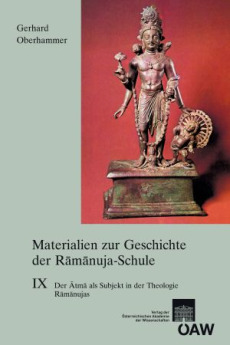Gerhard Oberhammer
Materialien zur Geschichte der Ramanuja-Schule IX
Der Atma als Subjekt in der Theologie Ramanujas
Reihe: Sitzungsberichte der philosophisch-historischen Klasse, Veröffentlichungen zu den Sprachen und Kulturen SüdasiensDieser neunte Teil der „Materialien zur Geschichte der Ramanuja-Schule” versucht Ramanujas philosophisch-theologische Lehre vom Atma als geistigem Subjekt, die in seinem Werk verstreut und im Zusammenhang verschiedener Probleme zur Sprache kommt, erstmals systematisch zu erschließen. Es zeigt sich, dass Ramanuja die unvollständig überlieferte philosophische Betrachtung des Atma, wie sie Yamunamuni in seiner Atmasiddhi? dargestellt hat, übernimmt, Atma aber durch die Einbindung in seine theologische Sicht des Brahma wesentlich als relationales Prinzip im Menschen versteht, das letztlich in religiös-spiritueller Sicht der „Ort“ möglicher Offenbarung und so menschlicher „Religion“ wird. Bemerkenswert ist, dass der Atma ontologisch eine relationale Einheit bildet, in der dank einer „ontologischen Differenz“ zwischen göttlichem und menschlichem Sein der Monismus vermieden wird. In einem zweiten Abschnitt, welcher der Rezeption von Ramanujas philosophisch-theologischer Reflexion des menschlichen Subjekts gewidmet ist, wird Naraya?aryas Kapitel über den Atma aus dessen Nitimala (ca. 12. Jh.) sowie in Auswahl Meghanadarisuris Darstellung des Atma seines Nayadyuma?i? übersetzt und kommentiert. Dabei zeigt sich ein Paradigmenwechsel der Darstellung, der sich dem Rückgriff auf Yamunamunis Atmasiddhi? verdankt: aus Ramanujas philosophisch-theologischer Reflexion des Subjektes wurde ein scholastischer „Traktat von der Seele“.
…
The ninth volume of the “Materialien zur Geschichte der Ramanuja-Schule” tries for the first time to systematically investigate Ramanuja”s philosophical-theological teaching on the Atma as a sentient subject, which in his work is dealt with in various places and in the context of various issues. The investigation has revealed that Ramanuja adopts the reflections on the Atma as are taught by Yamunamuni in his Atmasiddhi?, although these teachings have not been fully worked out. However, in integrating the Atma into his theological view of the Brahma, Ramanuja considers the Atma mainly as a relational prinicple in human beings that, in the end, becomes the “place” of possible revelation and thus the “place” of human “religion”. It is noteworthy that the Atma thus becomes ontologicallyy a relational unit with the divine Atma, in which monism is avoided due to an “ontological difference” between the divine and human
beings. The second section of the volume is devoted to the reception of Ramanuja”s philosophical-theological reflections on the human subject. This section offers a translation of and commentary on the chapter about the Atma in Naraya?arya”s Nitimala (12th cent.) as well as portions of Meghanadarisuri”s portrayal of the Atma in his Nayadyuma?i?. A paradigm shift can be seen thereby, due to their falling back on Yamunamuni”s Atmasiddhi?: a scholastic “treatise on the soul” was developed out of Ramanuja”s philosophical-theological reflections on this subject.

